MKT01906 - International Tourism System: Lumbini, Nepal Analysis
VerifiedAdded on 2023/03/30
|12
|2881
|128
Report
AI Summary
This report delves into the international tourism system of Lumbini, Nepal, a designated World Heritage Site and a significant Buddhist pilgrimage destination. It examines the factors attracting both national and international tourists, utilizing the Leiper Model to understand the dynamics between traveler-generating regions, tourist destinations, and transit routes. The report further assesses the positive and negative impacts of tourism on the host community, highlighting economic benefits such as increased income and job opportunities, alongside challenges like overpricing and infrastructural gaps. Key issues related to heritage preservation and multiculturalism are discussed, emphasizing the need to balance tourism development with the protection of Lumbini's cultural and religious significance. Finally, the report identifies policy implications aimed at promoting sustainable tourism and enhancing the overall visitor experience while safeguarding the interests of the local community. Desklib offers a range of study tools, including past papers and solved assignments.
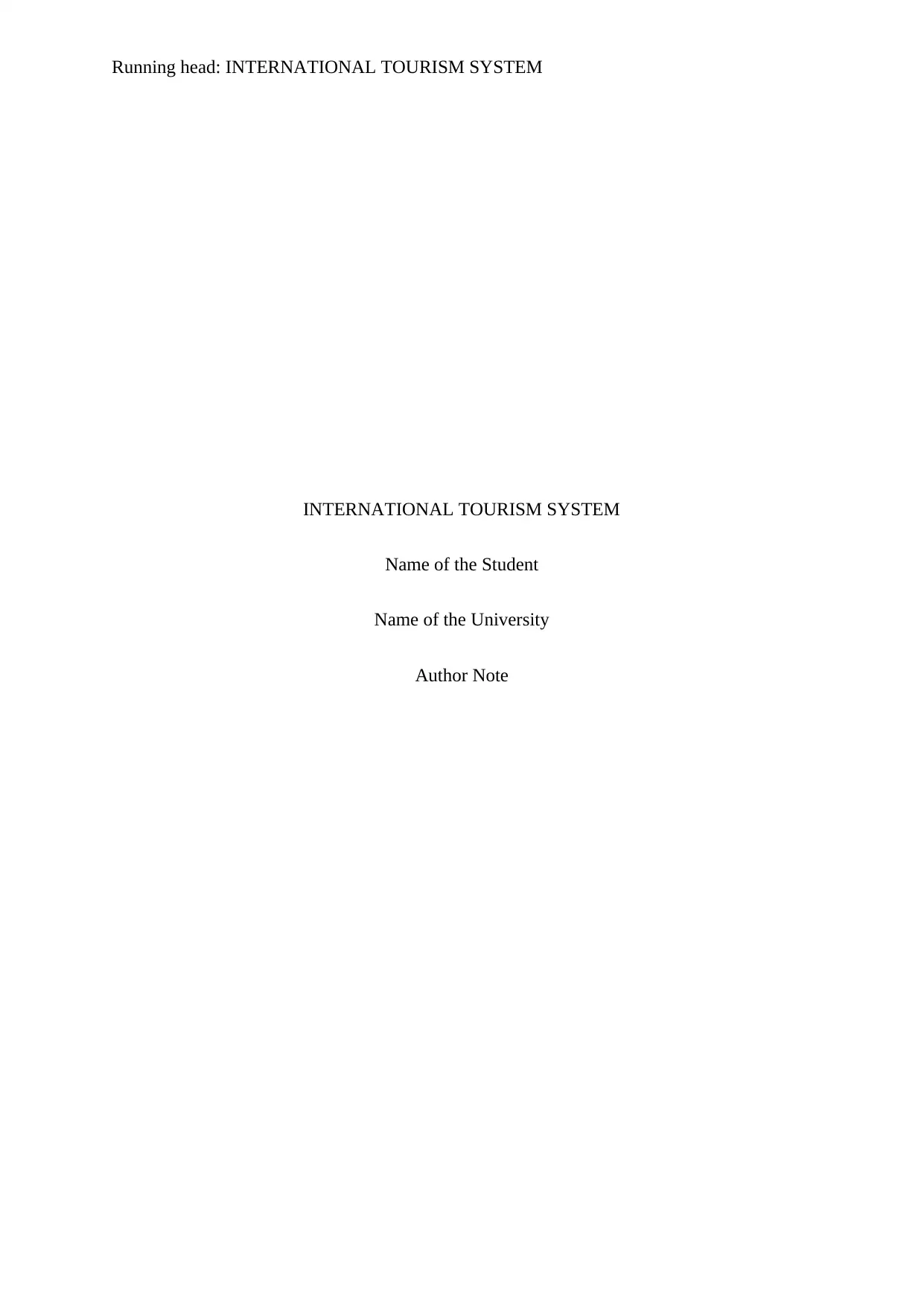
Running head: INTERNATIONAL TOURISM SYSTEM
INTERNATIONAL TOURISM SYSTEM
Name of the Student
Name of the University
Author Note
INTERNATIONAL TOURISM SYSTEM
Name of the Student
Name of the University
Author Note
Paraphrase This Document
Need a fresh take? Get an instant paraphrase of this document with our AI Paraphraser
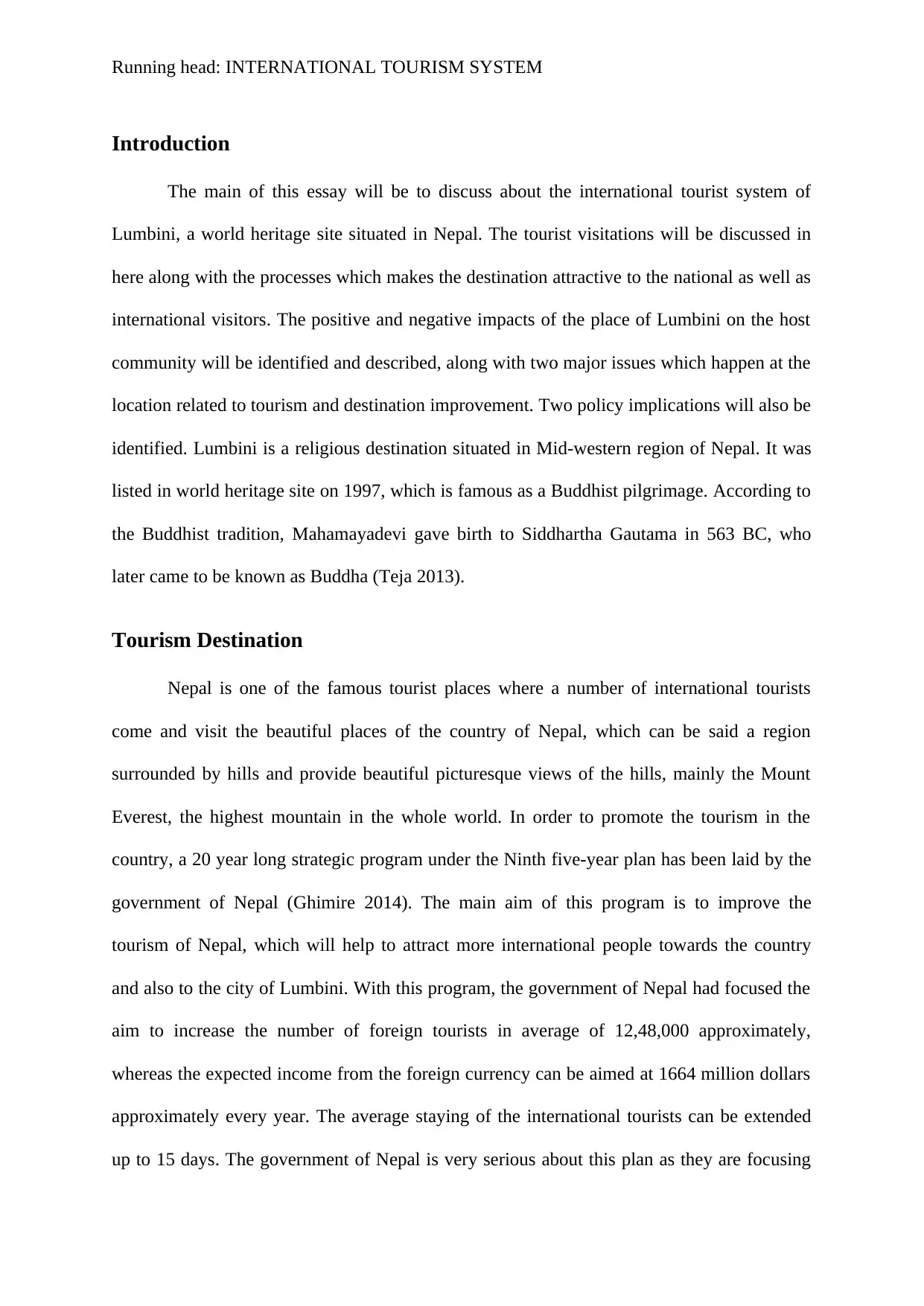
Running head: INTERNATIONAL TOURISM SYSTEM
Introduction
The main of this essay will be to discuss about the international tourist system of
Lumbini, a world heritage site situated in Nepal. The tourist visitations will be discussed in
here along with the processes which makes the destination attractive to the national as well as
international visitors. The positive and negative impacts of the place of Lumbini on the host
community will be identified and described, along with two major issues which happen at the
location related to tourism and destination improvement. Two policy implications will also be
identified. Lumbini is a religious destination situated in Mid-western region of Nepal. It was
listed in world heritage site on 1997, which is famous as a Buddhist pilgrimage. According to
the Buddhist tradition, Mahamayadevi gave birth to Siddhartha Gautama in 563 BC, who
later came to be known as Buddha (Teja 2013).
Tourism Destination
Nepal is one of the famous tourist places where a number of international tourists
come and visit the beautiful places of the country of Nepal, which can be said a region
surrounded by hills and provide beautiful picturesque views of the hills, mainly the Mount
Everest, the highest mountain in the whole world. In order to promote the tourism in the
country, a 20 year long strategic program under the Ninth five-year plan has been laid by the
government of Nepal (Ghimire 2014). The main aim of this program is to improve the
tourism of Nepal, which will help to attract more international people towards the country
and also to the city of Lumbini. With this program, the government of Nepal had focused the
aim to increase the number of foreign tourists in average of 12,48,000 approximately,
whereas the expected income from the foreign currency can be aimed at 1664 million dollars
approximately every year. The average staying of the international tourists can be extended
up to 15 days. The government of Nepal is very serious about this plan as they are focusing
Introduction
The main of this essay will be to discuss about the international tourist system of
Lumbini, a world heritage site situated in Nepal. The tourist visitations will be discussed in
here along with the processes which makes the destination attractive to the national as well as
international visitors. The positive and negative impacts of the place of Lumbini on the host
community will be identified and described, along with two major issues which happen at the
location related to tourism and destination improvement. Two policy implications will also be
identified. Lumbini is a religious destination situated in Mid-western region of Nepal. It was
listed in world heritage site on 1997, which is famous as a Buddhist pilgrimage. According to
the Buddhist tradition, Mahamayadevi gave birth to Siddhartha Gautama in 563 BC, who
later came to be known as Buddha (Teja 2013).
Tourism Destination
Nepal is one of the famous tourist places where a number of international tourists
come and visit the beautiful places of the country of Nepal, which can be said a region
surrounded by hills and provide beautiful picturesque views of the hills, mainly the Mount
Everest, the highest mountain in the whole world. In order to promote the tourism in the
country, a 20 year long strategic program under the Ninth five-year plan has been laid by the
government of Nepal (Ghimire 2014). The main aim of this program is to improve the
tourism of Nepal, which will help to attract more international people towards the country
and also to the city of Lumbini. With this program, the government of Nepal had focused the
aim to increase the number of foreign tourists in average of 12,48,000 approximately,
whereas the expected income from the foreign currency can be aimed at 1664 million dollars
approximately every year. The average staying of the international tourists can be extended
up to 15 days. The government of Nepal is very serious about this plan as they are focusing
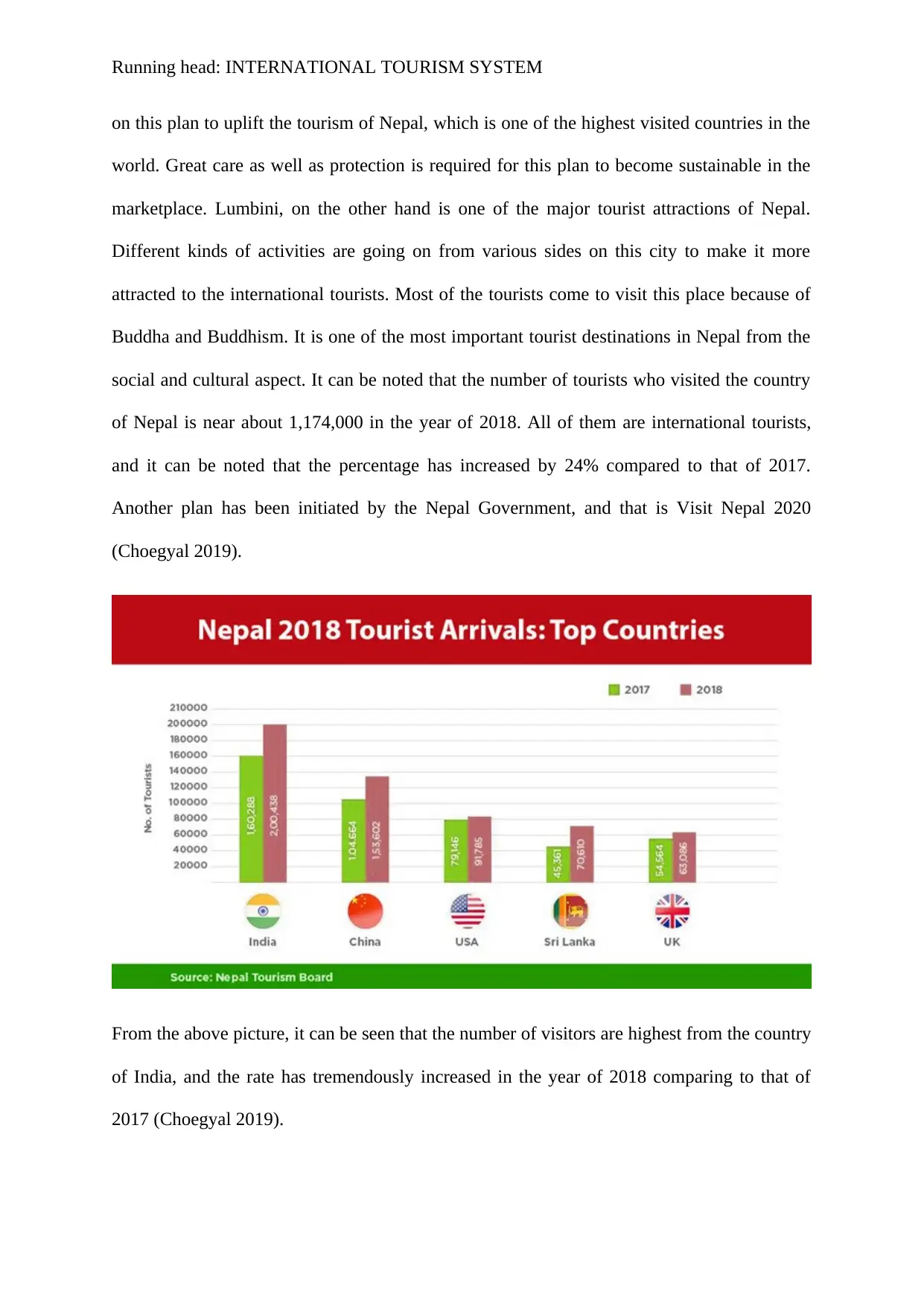
Running head: INTERNATIONAL TOURISM SYSTEM
on this plan to uplift the tourism of Nepal, which is one of the highest visited countries in the
world. Great care as well as protection is required for this plan to become sustainable in the
marketplace. Lumbini, on the other hand is one of the major tourist attractions of Nepal.
Different kinds of activities are going on from various sides on this city to make it more
attracted to the international tourists. Most of the tourists come to visit this place because of
Buddha and Buddhism. It is one of the most important tourist destinations in Nepal from the
social and cultural aspect. It can be noted that the number of tourists who visited the country
of Nepal is near about 1,174,000 in the year of 2018. All of them are international tourists,
and it can be noted that the percentage has increased by 24% compared to that of 2017.
Another plan has been initiated by the Nepal Government, and that is Visit Nepal 2020
(Choegyal 2019).
From the above picture, it can be seen that the number of visitors are highest from the country
of India, and the rate has tremendously increased in the year of 2018 comparing to that of
2017 (Choegyal 2019).
on this plan to uplift the tourism of Nepal, which is one of the highest visited countries in the
world. Great care as well as protection is required for this plan to become sustainable in the
marketplace. Lumbini, on the other hand is one of the major tourist attractions of Nepal.
Different kinds of activities are going on from various sides on this city to make it more
attracted to the international tourists. Most of the tourists come to visit this place because of
Buddha and Buddhism. It is one of the most important tourist destinations in Nepal from the
social and cultural aspect. It can be noted that the number of tourists who visited the country
of Nepal is near about 1,174,000 in the year of 2018. All of them are international tourists,
and it can be noted that the percentage has increased by 24% compared to that of 2017.
Another plan has been initiated by the Nepal Government, and that is Visit Nepal 2020
(Choegyal 2019).
From the above picture, it can be seen that the number of visitors are highest from the country
of India, and the rate has tremendously increased in the year of 2018 comparing to that of
2017 (Choegyal 2019).
⊘ This is a preview!⊘
Do you want full access?
Subscribe today to unlock all pages.

Trusted by 1+ million students worldwide
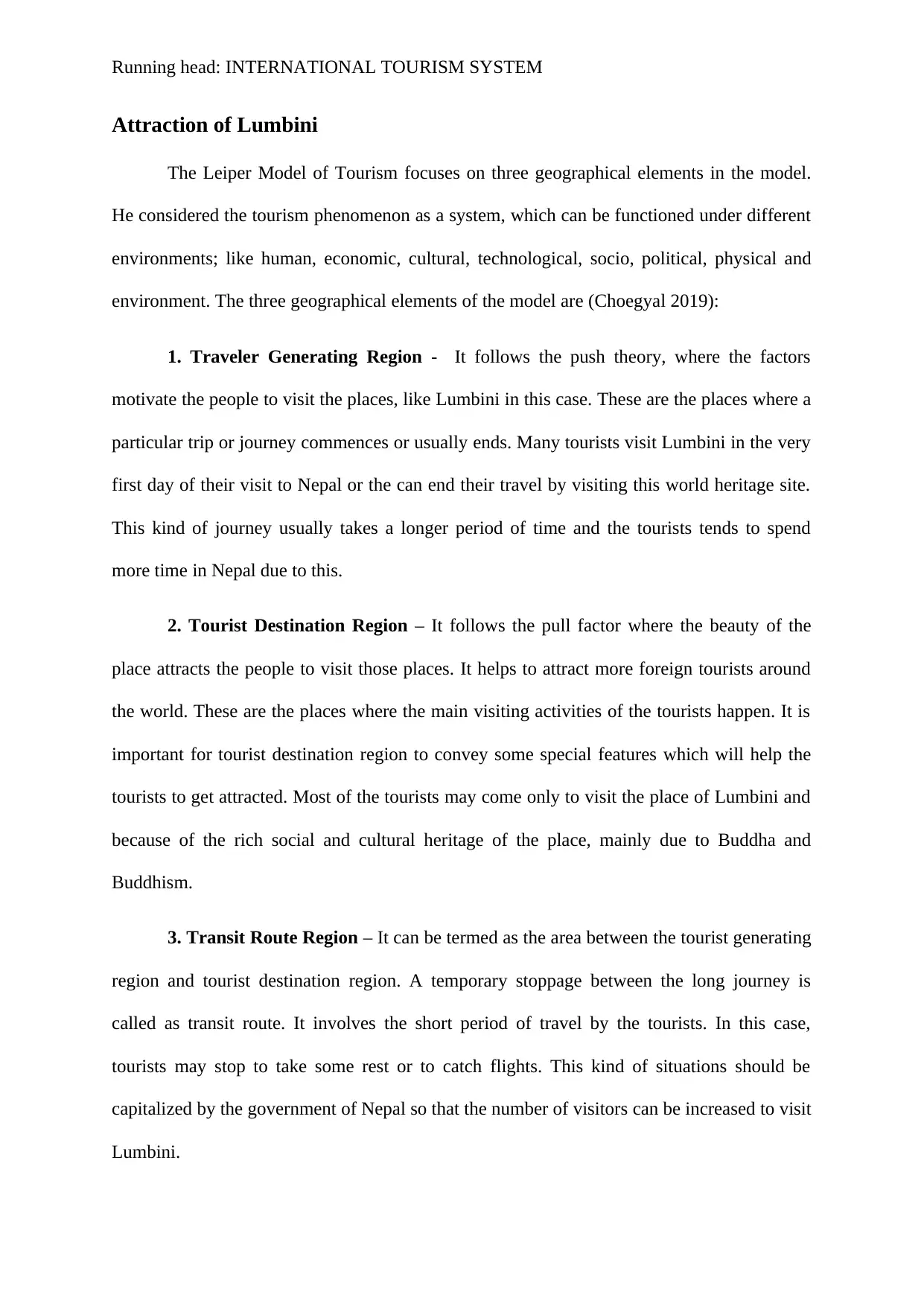
Running head: INTERNATIONAL TOURISM SYSTEM
Attraction of Lumbini
The Leiper Model of Tourism focuses on three geographical elements in the model.
He considered the tourism phenomenon as a system, which can be functioned under different
environments; like human, economic, cultural, technological, socio, political, physical and
environment. The three geographical elements of the model are (Choegyal 2019):
1. Traveler Generating Region - It follows the push theory, where the factors
motivate the people to visit the places, like Lumbini in this case. These are the places where a
particular trip or journey commences or usually ends. Many tourists visit Lumbini in the very
first day of their visit to Nepal or the can end their travel by visiting this world heritage site.
This kind of journey usually takes a longer period of time and the tourists tends to spend
more time in Nepal due to this.
2. Tourist Destination Region – It follows the pull factor where the beauty of the
place attracts the people to visit those places. It helps to attract more foreign tourists around
the world. These are the places where the main visiting activities of the tourists happen. It is
important for tourist destination region to convey some special features which will help the
tourists to get attracted. Most of the tourists may come only to visit the place of Lumbini and
because of the rich social and cultural heritage of the place, mainly due to Buddha and
Buddhism.
3. Transit Route Region – It can be termed as the area between the tourist generating
region and tourist destination region. A temporary stoppage between the long journey is
called as transit route. It involves the short period of travel by the tourists. In this case,
tourists may stop to take some rest or to catch flights. This kind of situations should be
capitalized by the government of Nepal so that the number of visitors can be increased to visit
Lumbini.
Attraction of Lumbini
The Leiper Model of Tourism focuses on three geographical elements in the model.
He considered the tourism phenomenon as a system, which can be functioned under different
environments; like human, economic, cultural, technological, socio, political, physical and
environment. The three geographical elements of the model are (Choegyal 2019):
1. Traveler Generating Region - It follows the push theory, where the factors
motivate the people to visit the places, like Lumbini in this case. These are the places where a
particular trip or journey commences or usually ends. Many tourists visit Lumbini in the very
first day of their visit to Nepal or the can end their travel by visiting this world heritage site.
This kind of journey usually takes a longer period of time and the tourists tends to spend
more time in Nepal due to this.
2. Tourist Destination Region – It follows the pull factor where the beauty of the
place attracts the people to visit those places. It helps to attract more foreign tourists around
the world. These are the places where the main visiting activities of the tourists happen. It is
important for tourist destination region to convey some special features which will help the
tourists to get attracted. Most of the tourists may come only to visit the place of Lumbini and
because of the rich social and cultural heritage of the place, mainly due to Buddha and
Buddhism.
3. Transit Route Region – It can be termed as the area between the tourist generating
region and tourist destination region. A temporary stoppage between the long journey is
called as transit route. It involves the short period of travel by the tourists. In this case,
tourists may stop to take some rest or to catch flights. This kind of situations should be
capitalized by the government of Nepal so that the number of visitors can be increased to visit
Lumbini.
Paraphrase This Document
Need a fresh take? Get an instant paraphrase of this document with our AI Paraphraser
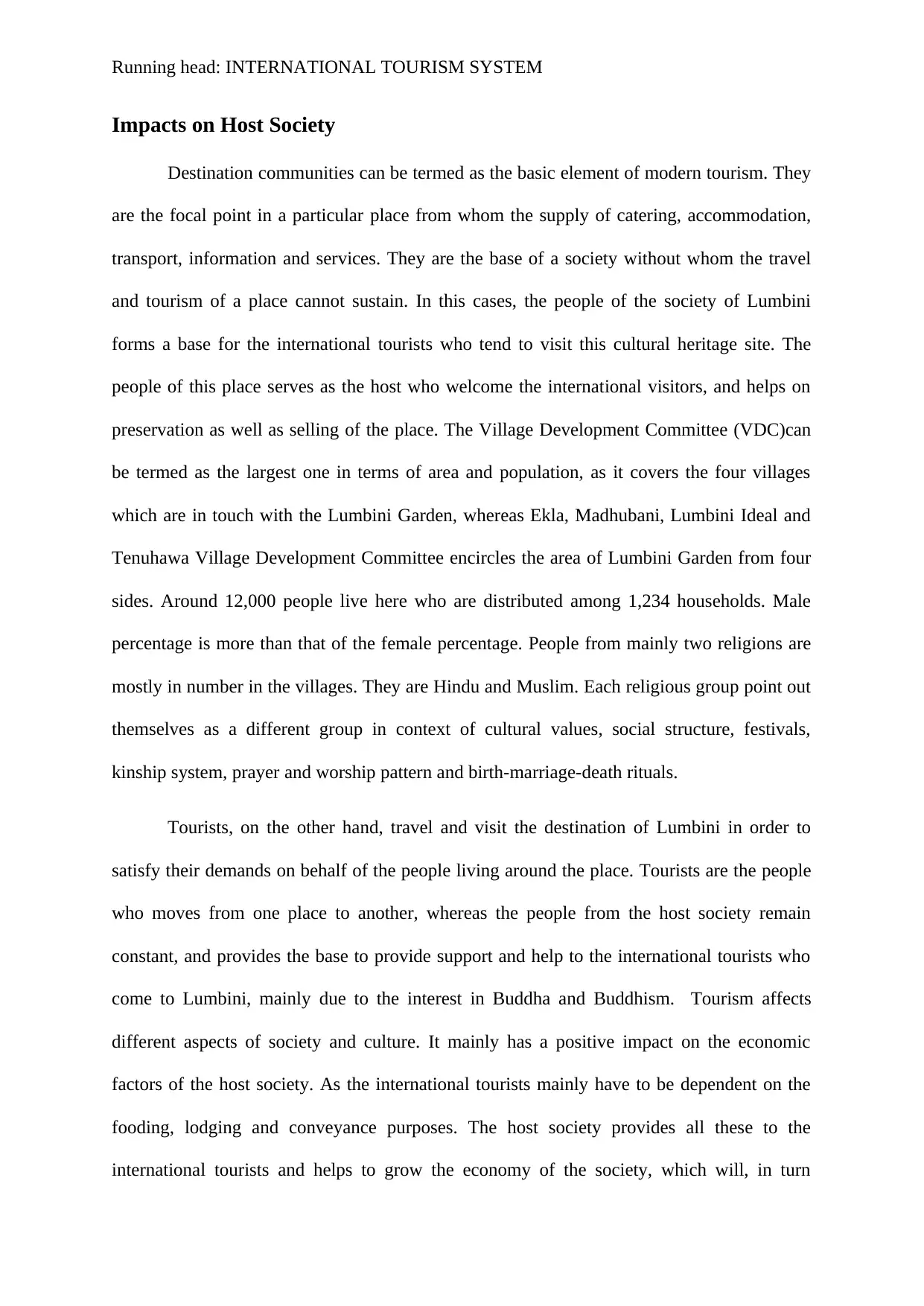
Running head: INTERNATIONAL TOURISM SYSTEM
Impacts on Host Society
Destination communities can be termed as the basic element of modern tourism. They
are the focal point in a particular place from whom the supply of catering, accommodation,
transport, information and services. They are the base of a society without whom the travel
and tourism of a place cannot sustain. In this cases, the people of the society of Lumbini
forms a base for the international tourists who tend to visit this cultural heritage site. The
people of this place serves as the host who welcome the international visitors, and helps on
preservation as well as selling of the place. The Village Development Committee (VDC)can
be termed as the largest one in terms of area and population, as it covers the four villages
which are in touch with the Lumbini Garden, whereas Ekla, Madhubani, Lumbini Ideal and
Tenuhawa Village Development Committee encircles the area of Lumbini Garden from four
sides. Around 12,000 people live here who are distributed among 1,234 households. Male
percentage is more than that of the female percentage. People from mainly two religions are
mostly in number in the villages. They are Hindu and Muslim. Each religious group point out
themselves as a different group in context of cultural values, social structure, festivals,
kinship system, prayer and worship pattern and birth-marriage-death rituals.
Tourists, on the other hand, travel and visit the destination of Lumbini in order to
satisfy their demands on behalf of the people living around the place. Tourists are the people
who moves from one place to another, whereas the people from the host society remain
constant, and provides the base to provide support and help to the international tourists who
come to Lumbini, mainly due to the interest in Buddha and Buddhism. Tourism affects
different aspects of society and culture. It mainly has a positive impact on the economic
factors of the host society. As the international tourists mainly have to be dependent on the
fooding, lodging and conveyance purposes. The host society provides all these to the
international tourists and helps to grow the economy of the society, which will, in turn
Impacts on Host Society
Destination communities can be termed as the basic element of modern tourism. They
are the focal point in a particular place from whom the supply of catering, accommodation,
transport, information and services. They are the base of a society without whom the travel
and tourism of a place cannot sustain. In this cases, the people of the society of Lumbini
forms a base for the international tourists who tend to visit this cultural heritage site. The
people of this place serves as the host who welcome the international visitors, and helps on
preservation as well as selling of the place. The Village Development Committee (VDC)can
be termed as the largest one in terms of area and population, as it covers the four villages
which are in touch with the Lumbini Garden, whereas Ekla, Madhubani, Lumbini Ideal and
Tenuhawa Village Development Committee encircles the area of Lumbini Garden from four
sides. Around 12,000 people live here who are distributed among 1,234 households. Male
percentage is more than that of the female percentage. People from mainly two religions are
mostly in number in the villages. They are Hindu and Muslim. Each religious group point out
themselves as a different group in context of cultural values, social structure, festivals,
kinship system, prayer and worship pattern and birth-marriage-death rituals.
Tourists, on the other hand, travel and visit the destination of Lumbini in order to
satisfy their demands on behalf of the people living around the place. Tourists are the people
who moves from one place to another, whereas the people from the host society remain
constant, and provides the base to provide support and help to the international tourists who
come to Lumbini, mainly due to the interest in Buddha and Buddhism. Tourism affects
different aspects of society and culture. It mainly has a positive impact on the economic
factors of the host society. As the international tourists mainly have to be dependent on the
fooding, lodging and conveyance purposes. The host society provides all these to the
international tourists and helps to grow the economy of the society, which will, in turn
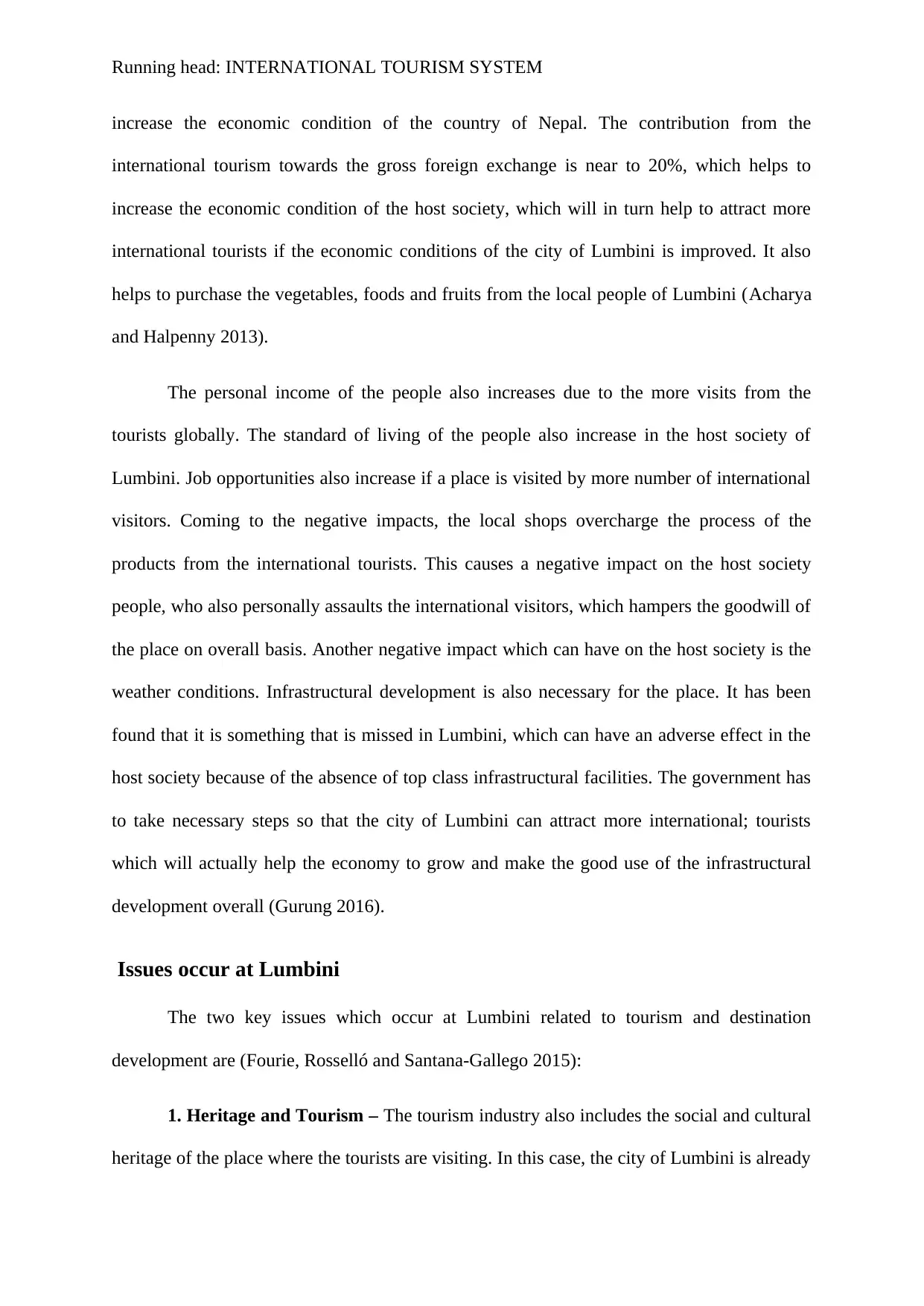
Running head: INTERNATIONAL TOURISM SYSTEM
increase the economic condition of the country of Nepal. The contribution from the
international tourism towards the gross foreign exchange is near to 20%, which helps to
increase the economic condition of the host society, which will in turn help to attract more
international tourists if the economic conditions of the city of Lumbini is improved. It also
helps to purchase the vegetables, foods and fruits from the local people of Lumbini (Acharya
and Halpenny 2013).
The personal income of the people also increases due to the more visits from the
tourists globally. The standard of living of the people also increase in the host society of
Lumbini. Job opportunities also increase if a place is visited by more number of international
visitors. Coming to the negative impacts, the local shops overcharge the process of the
products from the international tourists. This causes a negative impact on the host society
people, who also personally assaults the international visitors, which hampers the goodwill of
the place on overall basis. Another negative impact which can have on the host society is the
weather conditions. Infrastructural development is also necessary for the place. It has been
found that it is something that is missed in Lumbini, which can have an adverse effect in the
host society because of the absence of top class infrastructural facilities. The government has
to take necessary steps so that the city of Lumbini can attract more international; tourists
which will actually help the economy to grow and make the good use of the infrastructural
development overall (Gurung 2016).
Issues occur at Lumbini
The two key issues which occur at Lumbini related to tourism and destination
development are (Fourie, Rosselló and Santana‐Gallego 2015):
1. Heritage and Tourism – The tourism industry also includes the social and cultural
heritage of the place where the tourists are visiting. In this case, the city of Lumbini is already
increase the economic condition of the country of Nepal. The contribution from the
international tourism towards the gross foreign exchange is near to 20%, which helps to
increase the economic condition of the host society, which will in turn help to attract more
international tourists if the economic conditions of the city of Lumbini is improved. It also
helps to purchase the vegetables, foods and fruits from the local people of Lumbini (Acharya
and Halpenny 2013).
The personal income of the people also increases due to the more visits from the
tourists globally. The standard of living of the people also increase in the host society of
Lumbini. Job opportunities also increase if a place is visited by more number of international
visitors. Coming to the negative impacts, the local shops overcharge the process of the
products from the international tourists. This causes a negative impact on the host society
people, who also personally assaults the international visitors, which hampers the goodwill of
the place on overall basis. Another negative impact which can have on the host society is the
weather conditions. Infrastructural development is also necessary for the place. It has been
found that it is something that is missed in Lumbini, which can have an adverse effect in the
host society because of the absence of top class infrastructural facilities. The government has
to take necessary steps so that the city of Lumbini can attract more international; tourists
which will actually help the economy to grow and make the good use of the infrastructural
development overall (Gurung 2016).
Issues occur at Lumbini
The two key issues which occur at Lumbini related to tourism and destination
development are (Fourie, Rosselló and Santana‐Gallego 2015):
1. Heritage and Tourism – The tourism industry also includes the social and cultural
heritage of the place where the tourists are visiting. In this case, the city of Lumbini is already
⊘ This is a preview!⊘
Do you want full access?
Subscribe today to unlock all pages.

Trusted by 1+ million students worldwide
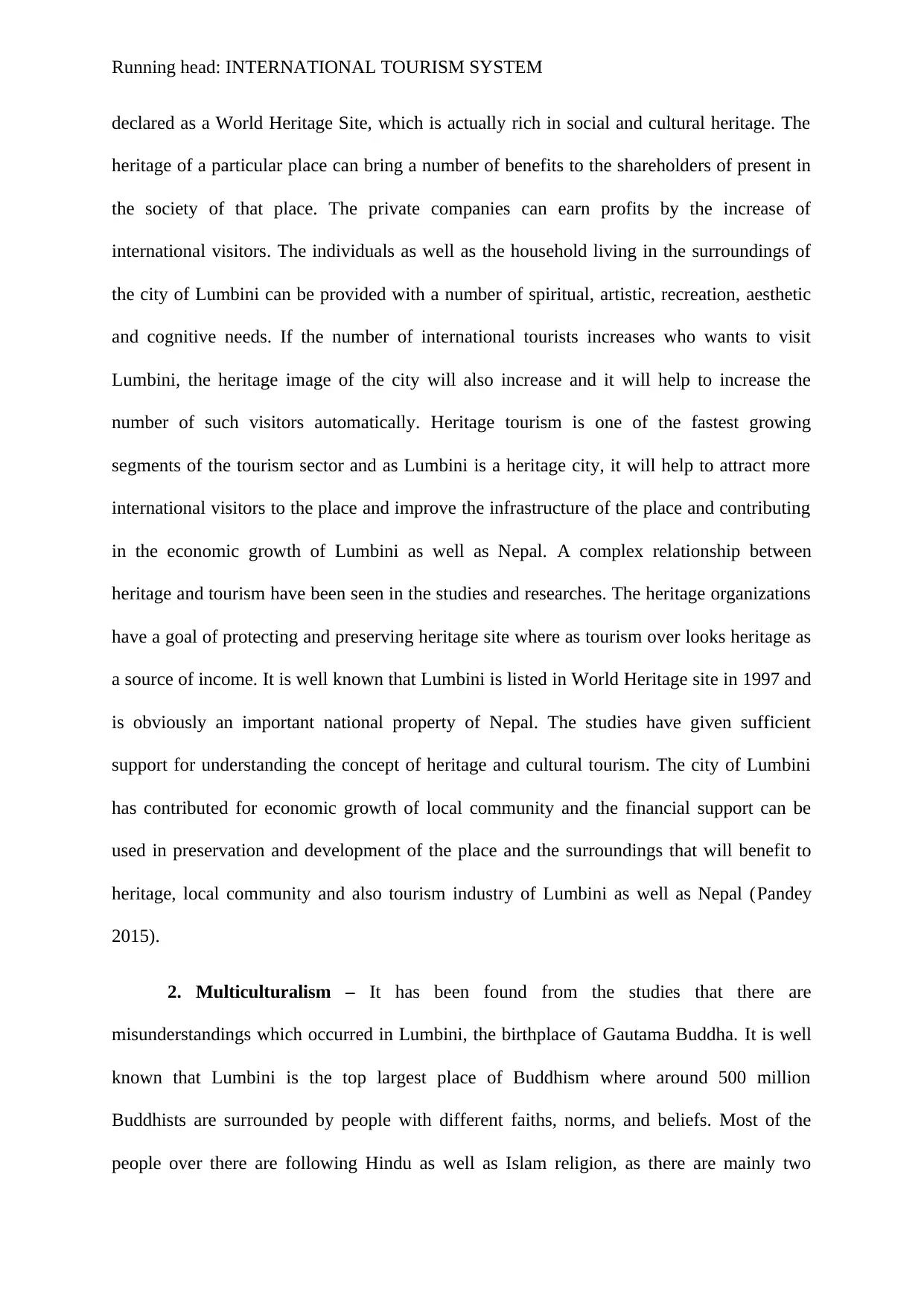
Running head: INTERNATIONAL TOURISM SYSTEM
declared as a World Heritage Site, which is actually rich in social and cultural heritage. The
heritage of a particular place can bring a number of benefits to the shareholders of present in
the society of that place. The private companies can earn profits by the increase of
international visitors. The individuals as well as the household living in the surroundings of
the city of Lumbini can be provided with a number of spiritual, artistic, recreation, aesthetic
and cognitive needs. If the number of international tourists increases who wants to visit
Lumbini, the heritage image of the city will also increase and it will help to increase the
number of such visitors automatically. Heritage tourism is one of the fastest growing
segments of the tourism sector and as Lumbini is a heritage city, it will help to attract more
international visitors to the place and improve the infrastructure of the place and contributing
in the economic growth of Lumbini as well as Nepal. A complex relationship between
heritage and tourism have been seen in the studies and researches. The heritage organizations
have a goal of protecting and preserving heritage site where as tourism over looks heritage as
a source of income. It is well known that Lumbini is listed in World Heritage site in 1997 and
is obviously an important national property of Nepal. The studies have given sufficient
support for understanding the concept of heritage and cultural tourism. The city of Lumbini
has contributed for economic growth of local community and the financial support can be
used in preservation and development of the place and the surroundings that will benefit to
heritage, local community and also tourism industry of Lumbini as well as Nepal (Pandey
2015).
2. Multiculturalism – It has been found from the studies that there are
misunderstandings which occurred in Lumbini, the birthplace of Gautama Buddha. It is well
known that Lumbini is the top largest place of Buddhism where around 500 million
Buddhists are surrounded by people with different faiths, norms, and beliefs. Most of the
people over there are following Hindu as well as Islam religion, as there are mainly two
declared as a World Heritage Site, which is actually rich in social and cultural heritage. The
heritage of a particular place can bring a number of benefits to the shareholders of present in
the society of that place. The private companies can earn profits by the increase of
international visitors. The individuals as well as the household living in the surroundings of
the city of Lumbini can be provided with a number of spiritual, artistic, recreation, aesthetic
and cognitive needs. If the number of international tourists increases who wants to visit
Lumbini, the heritage image of the city will also increase and it will help to increase the
number of such visitors automatically. Heritage tourism is one of the fastest growing
segments of the tourism sector and as Lumbini is a heritage city, it will help to attract more
international visitors to the place and improve the infrastructure of the place and contributing
in the economic growth of Lumbini as well as Nepal. A complex relationship between
heritage and tourism have been seen in the studies and researches. The heritage organizations
have a goal of protecting and preserving heritage site where as tourism over looks heritage as
a source of income. It is well known that Lumbini is listed in World Heritage site in 1997 and
is obviously an important national property of Nepal. The studies have given sufficient
support for understanding the concept of heritage and cultural tourism. The city of Lumbini
has contributed for economic growth of local community and the financial support can be
used in preservation and development of the place and the surroundings that will benefit to
heritage, local community and also tourism industry of Lumbini as well as Nepal (Pandey
2015).
2. Multiculturalism – It has been found from the studies that there are
misunderstandings which occurred in Lumbini, the birthplace of Gautama Buddha. It is well
known that Lumbini is the top largest place of Buddhism where around 500 million
Buddhists are surrounded by people with different faiths, norms, and beliefs. Most of the
people over there are following Hindu as well as Islam religion, as there are mainly two
Paraphrase This Document
Need a fresh take? Get an instant paraphrase of this document with our AI Paraphraser
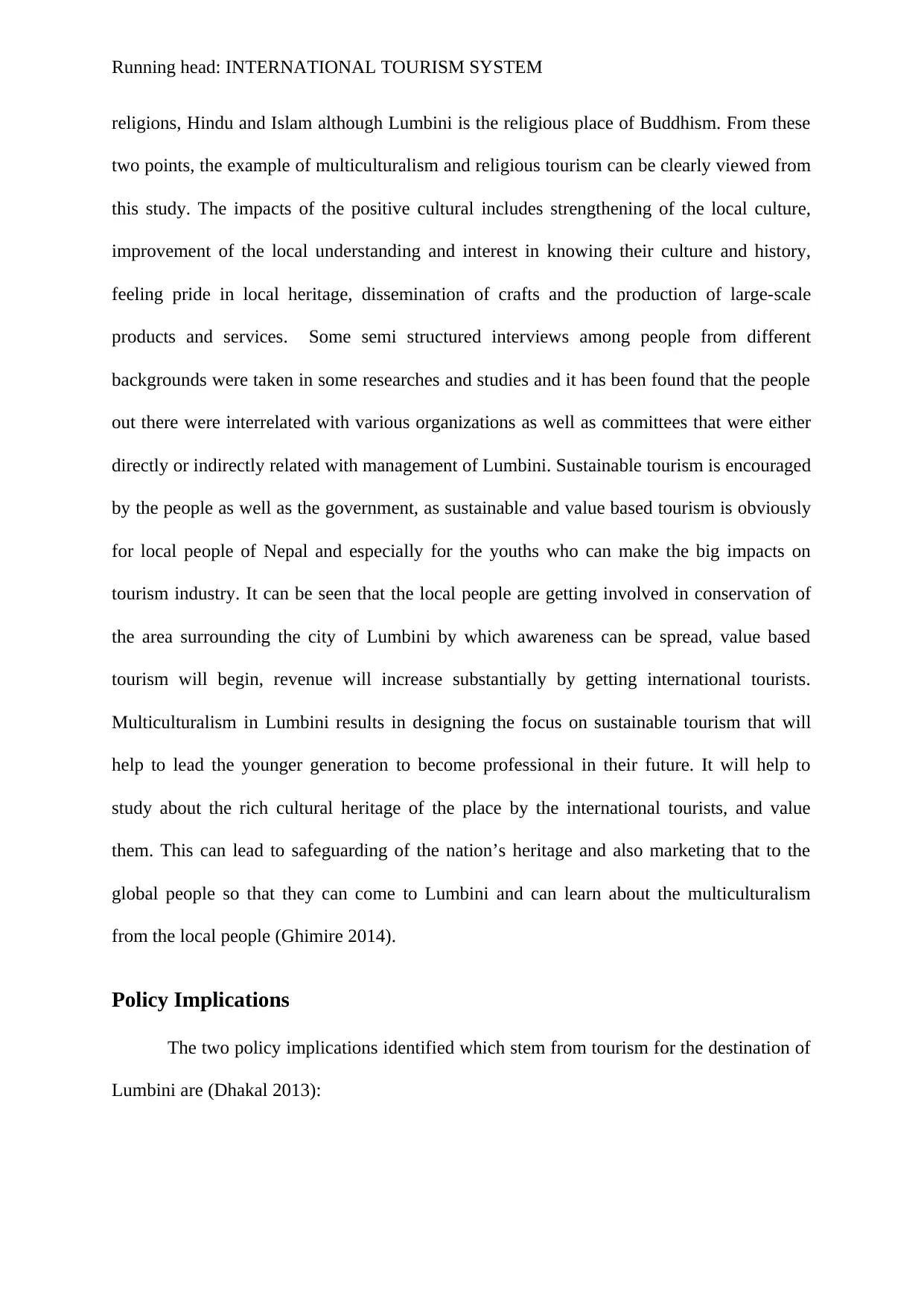
Running head: INTERNATIONAL TOURISM SYSTEM
religions, Hindu and Islam although Lumbini is the religious place of Buddhism. From these
two points, the example of multiculturalism and religious tourism can be clearly viewed from
this study. The impacts of the positive cultural includes strengthening of the local culture,
improvement of the local understanding and interest in knowing their culture and history,
feeling pride in local heritage, dissemination of crafts and the production of large-scale
products and services. Some semi structured interviews among people from different
backgrounds were taken in some researches and studies and it has been found that the people
out there were interrelated with various organizations as well as committees that were either
directly or indirectly related with management of Lumbini. Sustainable tourism is encouraged
by the people as well as the government, as sustainable and value based tourism is obviously
for local people of Nepal and especially for the youths who can make the big impacts on
tourism industry. It can be seen that the local people are getting involved in conservation of
the area surrounding the city of Lumbini by which awareness can be spread, value based
tourism will begin, revenue will increase substantially by getting international tourists.
Multiculturalism in Lumbini results in designing the focus on sustainable tourism that will
help to lead the younger generation to become professional in their future. It will help to
study about the rich cultural heritage of the place by the international tourists, and value
them. This can lead to safeguarding of the nation’s heritage and also marketing that to the
global people so that they can come to Lumbini and can learn about the multiculturalism
from the local people (Ghimire 2014).
Policy Implications
The two policy implications identified which stem from tourism for the destination of
Lumbini are (Dhakal 2013):
religions, Hindu and Islam although Lumbini is the religious place of Buddhism. From these
two points, the example of multiculturalism and religious tourism can be clearly viewed from
this study. The impacts of the positive cultural includes strengthening of the local culture,
improvement of the local understanding and interest in knowing their culture and history,
feeling pride in local heritage, dissemination of crafts and the production of large-scale
products and services. Some semi structured interviews among people from different
backgrounds were taken in some researches and studies and it has been found that the people
out there were interrelated with various organizations as well as committees that were either
directly or indirectly related with management of Lumbini. Sustainable tourism is encouraged
by the people as well as the government, as sustainable and value based tourism is obviously
for local people of Nepal and especially for the youths who can make the big impacts on
tourism industry. It can be seen that the local people are getting involved in conservation of
the area surrounding the city of Lumbini by which awareness can be spread, value based
tourism will begin, revenue will increase substantially by getting international tourists.
Multiculturalism in Lumbini results in designing the focus on sustainable tourism that will
help to lead the younger generation to become professional in their future. It will help to
study about the rich cultural heritage of the place by the international tourists, and value
them. This can lead to safeguarding of the nation’s heritage and also marketing that to the
global people so that they can come to Lumbini and can learn about the multiculturalism
from the local people (Ghimire 2014).
Policy Implications
The two policy implications identified which stem from tourism for the destination of
Lumbini are (Dhakal 2013):
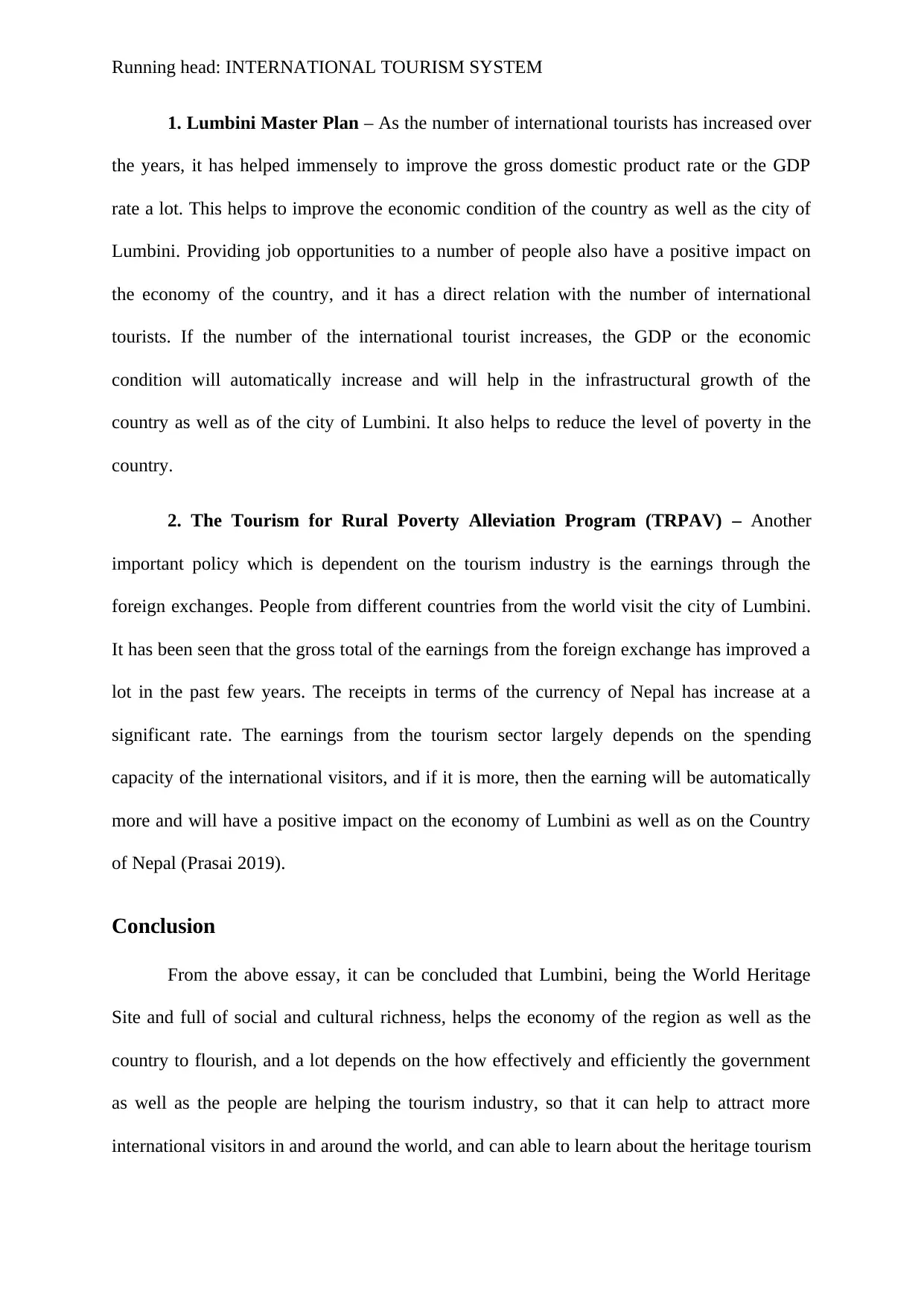
Running head: INTERNATIONAL TOURISM SYSTEM
1. Lumbini Master Plan – As the number of international tourists has increased over
the years, it has helped immensely to improve the gross domestic product rate or the GDP
rate a lot. This helps to improve the economic condition of the country as well as the city of
Lumbini. Providing job opportunities to a number of people also have a positive impact on
the economy of the country, and it has a direct relation with the number of international
tourists. If the number of the international tourist increases, the GDP or the economic
condition will automatically increase and will help in the infrastructural growth of the
country as well as of the city of Lumbini. It also helps to reduce the level of poverty in the
country.
2. The Tourism for Rural Poverty Alleviation Program (TRPAV) – Another
important policy which is dependent on the tourism industry is the earnings through the
foreign exchanges. People from different countries from the world visit the city of Lumbini.
It has been seen that the gross total of the earnings from the foreign exchange has improved a
lot in the past few years. The receipts in terms of the currency of Nepal has increase at a
significant rate. The earnings from the tourism sector largely depends on the spending
capacity of the international visitors, and if it is more, then the earning will be automatically
more and will have a positive impact on the economy of Lumbini as well as on the Country
of Nepal (Prasai 2019).
Conclusion
From the above essay, it can be concluded that Lumbini, being the World Heritage
Site and full of social and cultural richness, helps the economy of the region as well as the
country to flourish, and a lot depends on the how effectively and efficiently the government
as well as the people are helping the tourism industry, so that it can help to attract more
international visitors in and around the world, and can able to learn about the heritage tourism
1. Lumbini Master Plan – As the number of international tourists has increased over
the years, it has helped immensely to improve the gross domestic product rate or the GDP
rate a lot. This helps to improve the economic condition of the country as well as the city of
Lumbini. Providing job opportunities to a number of people also have a positive impact on
the economy of the country, and it has a direct relation with the number of international
tourists. If the number of the international tourist increases, the GDP or the economic
condition will automatically increase and will help in the infrastructural growth of the
country as well as of the city of Lumbini. It also helps to reduce the level of poverty in the
country.
2. The Tourism for Rural Poverty Alleviation Program (TRPAV) – Another
important policy which is dependent on the tourism industry is the earnings through the
foreign exchanges. People from different countries from the world visit the city of Lumbini.
It has been seen that the gross total of the earnings from the foreign exchange has improved a
lot in the past few years. The receipts in terms of the currency of Nepal has increase at a
significant rate. The earnings from the tourism sector largely depends on the spending
capacity of the international visitors, and if it is more, then the earning will be automatically
more and will have a positive impact on the economy of Lumbini as well as on the Country
of Nepal (Prasai 2019).
Conclusion
From the above essay, it can be concluded that Lumbini, being the World Heritage
Site and full of social and cultural richness, helps the economy of the region as well as the
country to flourish, and a lot depends on the how effectively and efficiently the government
as well as the people are helping the tourism industry, so that it can help to attract more
international visitors in and around the world, and can able to learn about the heritage tourism
⊘ This is a preview!⊘
Do you want full access?
Subscribe today to unlock all pages.

Trusted by 1+ million students worldwide

Running head: INTERNATIONAL TOURISM SYSTEM
as well as multiculturalism from the city of Lumbini. The city has attracted thousands of
visitors and will do the same in future also, only sustainability about holding the heritage and
valuing the multiculturalism.
as well as multiculturalism from the city of Lumbini. The city has attracted thousands of
visitors and will do the same in future also, only sustainability about holding the heritage and
valuing the multiculturalism.
Paraphrase This Document
Need a fresh take? Get an instant paraphrase of this document with our AI Paraphraser
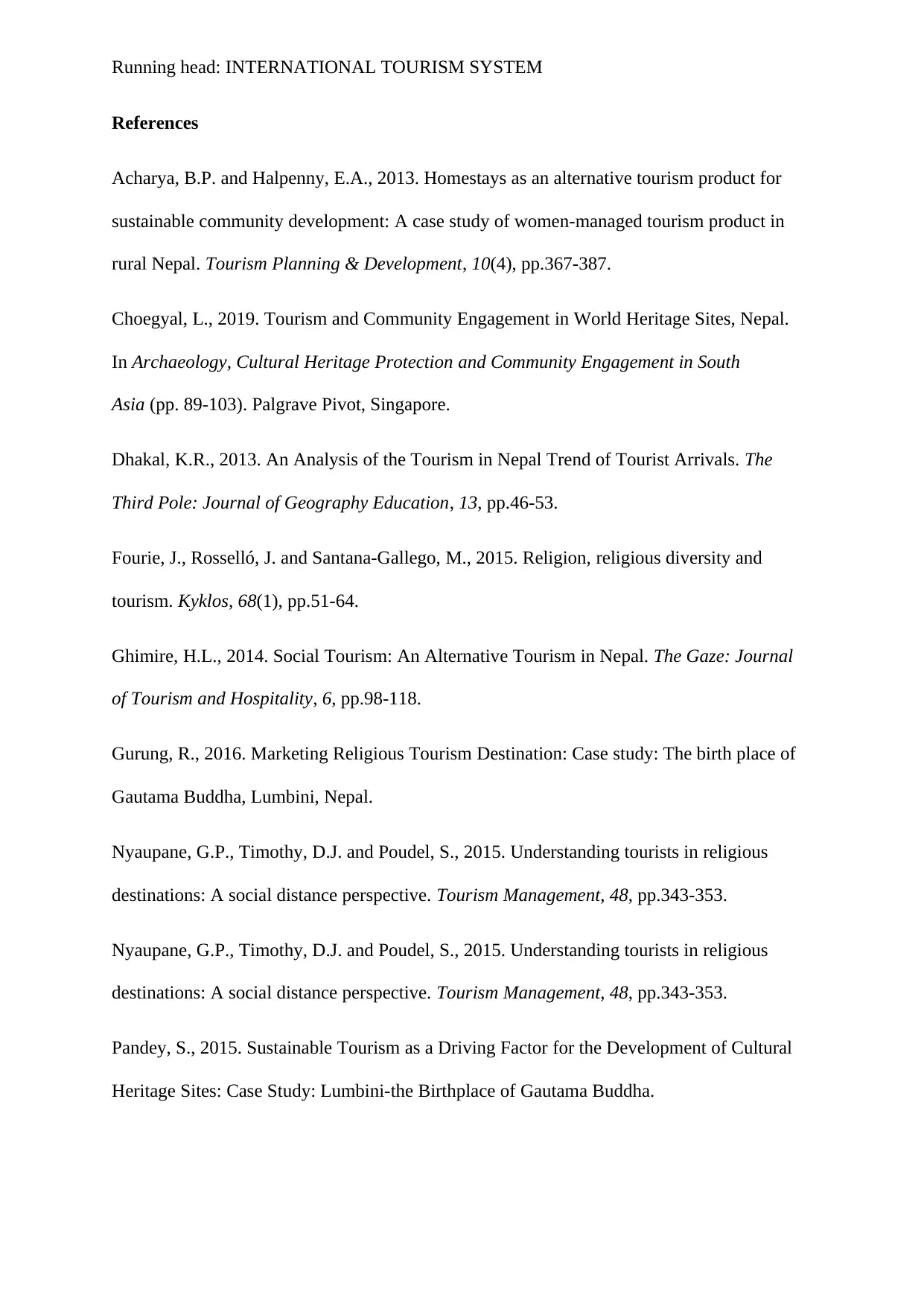
Running head: INTERNATIONAL TOURISM SYSTEM
References
Acharya, B.P. and Halpenny, E.A., 2013. Homestays as an alternative tourism product for
sustainable community development: A case study of women-managed tourism product in
rural Nepal. Tourism Planning & Development, 10(4), pp.367-387.
Choegyal, L., 2019. Tourism and Community Engagement in World Heritage Sites, Nepal.
In Archaeology, Cultural Heritage Protection and Community Engagement in South
Asia (pp. 89-103). Palgrave Pivot, Singapore.
Dhakal, K.R., 2013. An Analysis of the Tourism in Nepal Trend of Tourist Arrivals. The
Third Pole: Journal of Geography Education, 13, pp.46-53.
Fourie, J., Rosselló, J. and Santana‐Gallego, M., 2015. Religion, religious diversity and
tourism. Kyklos, 68(1), pp.51-64.
Ghimire, H.L., 2014. Social Tourism: An Alternative Tourism in Nepal. The Gaze: Journal
of Tourism and Hospitality, 6, pp.98-118.
Gurung, R., 2016. Marketing Religious Tourism Destination: Case study: The birth place of
Gautama Buddha, Lumbini, Nepal.
Nyaupane, G.P., Timothy, D.J. and Poudel, S., 2015. Understanding tourists in religious
destinations: A social distance perspective. Tourism Management, 48, pp.343-353.
Nyaupane, G.P., Timothy, D.J. and Poudel, S., 2015. Understanding tourists in religious
destinations: A social distance perspective. Tourism Management, 48, pp.343-353.
Pandey, S., 2015. Sustainable Tourism as a Driving Factor for the Development of Cultural
Heritage Sites: Case Study: Lumbini-the Birthplace of Gautama Buddha.
References
Acharya, B.P. and Halpenny, E.A., 2013. Homestays as an alternative tourism product for
sustainable community development: A case study of women-managed tourism product in
rural Nepal. Tourism Planning & Development, 10(4), pp.367-387.
Choegyal, L., 2019. Tourism and Community Engagement in World Heritage Sites, Nepal.
In Archaeology, Cultural Heritage Protection and Community Engagement in South
Asia (pp. 89-103). Palgrave Pivot, Singapore.
Dhakal, K.R., 2013. An Analysis of the Tourism in Nepal Trend of Tourist Arrivals. The
Third Pole: Journal of Geography Education, 13, pp.46-53.
Fourie, J., Rosselló, J. and Santana‐Gallego, M., 2015. Religion, religious diversity and
tourism. Kyklos, 68(1), pp.51-64.
Ghimire, H.L., 2014. Social Tourism: An Alternative Tourism in Nepal. The Gaze: Journal
of Tourism and Hospitality, 6, pp.98-118.
Gurung, R., 2016. Marketing Religious Tourism Destination: Case study: The birth place of
Gautama Buddha, Lumbini, Nepal.
Nyaupane, G.P., Timothy, D.J. and Poudel, S., 2015. Understanding tourists in religious
destinations: A social distance perspective. Tourism Management, 48, pp.343-353.
Nyaupane, G.P., Timothy, D.J. and Poudel, S., 2015. Understanding tourists in religious
destinations: A social distance perspective. Tourism Management, 48, pp.343-353.
Pandey, S., 2015. Sustainable Tourism as a Driving Factor for the Development of Cultural
Heritage Sites: Case Study: Lumbini-the Birthplace of Gautama Buddha.
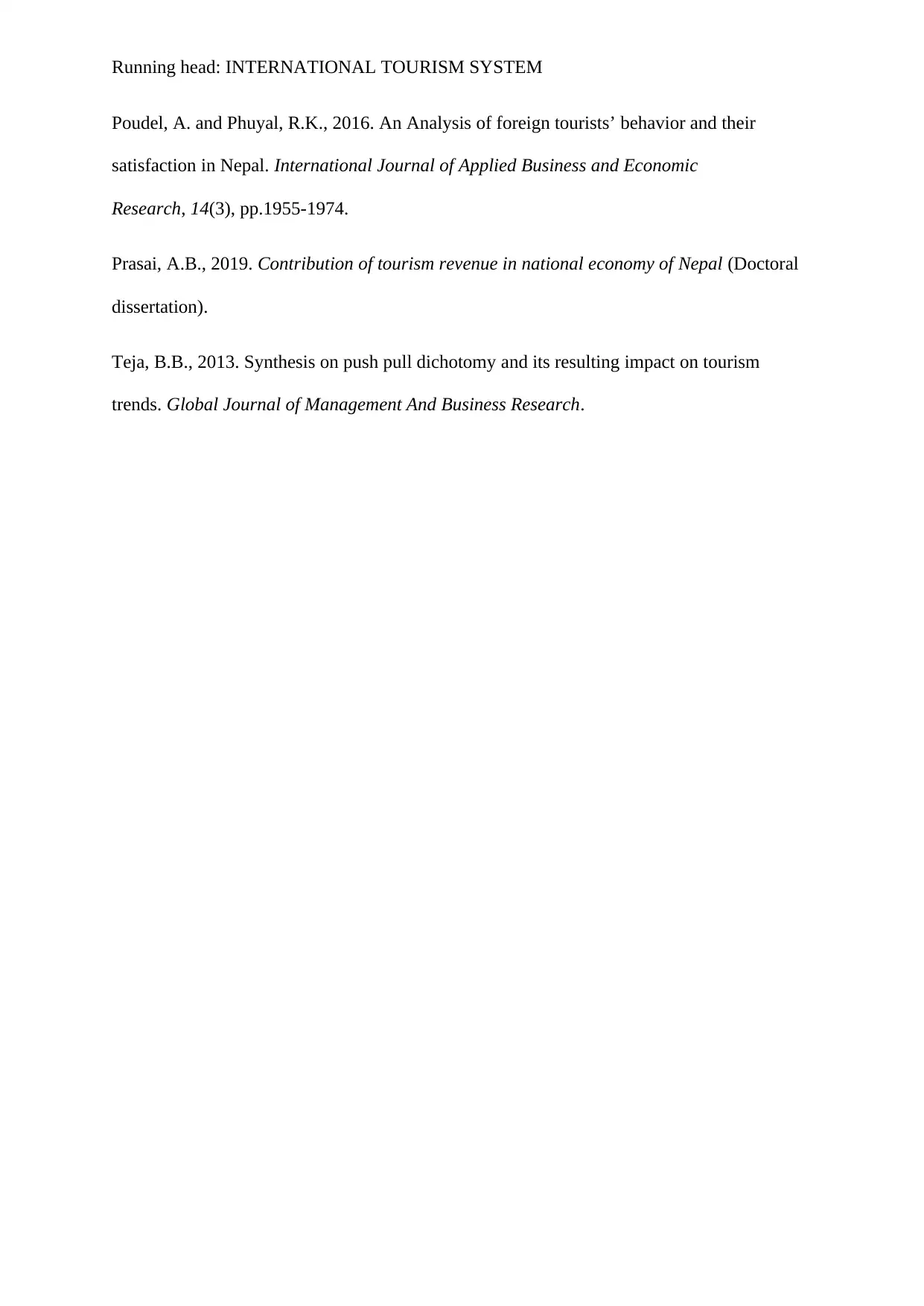
Running head: INTERNATIONAL TOURISM SYSTEM
Poudel, A. and Phuyal, R.K., 2016. An Analysis of foreign tourists’ behavior and their
satisfaction in Nepal. International Journal of Applied Business and Economic
Research, 14(3), pp.1955-1974.
Prasai, A.B., 2019. Contribution of tourism revenue in national economy of Nepal (Doctoral
dissertation).
Teja, B.B., 2013. Synthesis on push pull dichotomy and its resulting impact on tourism
trends. Global Journal of Management And Business Research.
Poudel, A. and Phuyal, R.K., 2016. An Analysis of foreign tourists’ behavior and their
satisfaction in Nepal. International Journal of Applied Business and Economic
Research, 14(3), pp.1955-1974.
Prasai, A.B., 2019. Contribution of tourism revenue in national economy of Nepal (Doctoral
dissertation).
Teja, B.B., 2013. Synthesis on push pull dichotomy and its resulting impact on tourism
trends. Global Journal of Management And Business Research.
⊘ This is a preview!⊘
Do you want full access?
Subscribe today to unlock all pages.

Trusted by 1+ million students worldwide
1 out of 12
Related Documents
Your All-in-One AI-Powered Toolkit for Academic Success.
+13062052269
info@desklib.com
Available 24*7 on WhatsApp / Email
![[object Object]](/_next/static/media/star-bottom.7253800d.svg)
Unlock your academic potential
Copyright © 2020–2025 A2Z Services. All Rights Reserved. Developed and managed by ZUCOL.





